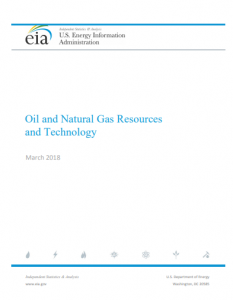Full Title: Oil and Natural Gas Resources and Technology
Author(s): U.S. Energy Information Organization (EIA)
Publisher(s): U.S. Department of Energy
Publication Date: March 1, 2018
Full Text: Download Resource
Description (excerpt):
Future growth in U.S. crude oil and natural gas production is projected to be driven by the development
of tight oil and shale gas resources. However, a great deal of uncertainty surrounds this result. In
particular, future domestic tight oil and shale gas production depends on the quality of the resources,
the evolution of technological and operational improvements to increase productivity per well and to
reduce costs, and the market prices determined in a diverse market of producers and consumers, all of
which are highly uncertain. This article provides background on the analysis of the estimated ultimate
recovery per well (EUR), a key assumption underlying the projections, and it provides a detailed
discussion of the sensitivity of results across Annual Energy Outlook 2018 (AEO2018) cases.
The outlook for domestic crude oil and natural gas production is highly sensitive to resource and
technology assumptions. In the AEO2018 Reference case, domestic crude oil production increases over
the next five years and then generally flattens after 2022, staying about 11 million to 12 million barrels
per day (b/d) through 2050. Similarly, domestic dry natural gas production increases rapidly (more than
5% annually) through 2021 and then slows to an annual average growth rate of 1% through 2050,
reaching 43.0 trillion cubic feet (Tcf) per year in 2050 in the Reference case. In the High Oil and Gas
Resource and Technology case, domestic crude oil and dry natural gas production increases through
2050, reaching 19.1 million b/d and 55.3 Tcf/year, respectively, in 2050. In the Low Oil and Gas Resource
and Technology case, domestic crude oil production decreases for most of the projection period, and
dry natural gas production stays near 30 Tcf/year from 2018 through 2050.
